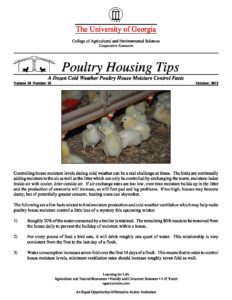Controlling house moisture levels during cold weather can be a real challenge at times. The birds are continually adding moisture to the air as well as the litter which can only be controlled by exchanging the warm, moisture-laden inside air with cooler, drier outside air. If air exchange rates are too low, over time moisture builds up in the litter and the production of ammonia will increase, as will foot pad and leg problems. If too high, houses may become dusty; but of potentially greater ...concern, heating costs can skyrocket.
The following are a few facts related to bird moisture production and cold weather ventilation which may help make poultry house moisture control a little less of a mystery this upcoming winter:
1) Roughly 20% of the water consumed by a broiler is retained. The remaining 80% needs to be removed from the house daily to prevent the buildup of moisture within a house.
2) For every pound of feed a bird eats, it will drink roughly one quart of water. This relationship is very consistent from the first to the last day of a flock.
3) Water consumption increases seven fold over the first 14 days of a flock. This means that in order to control house moisture levels, minimum ventilation rates should increase roughly seven fold as well.
4) Due to increased growth rates, if a producer wants to control house moisture levels, minimum ventilation rates need to be roughly 20% higher than they were ten years ago.
5) By seven weeks of age, the typical broiler has added roughly two gallons of moisture to the air and litter in a house. If none of the moisture were to be removed, there would be four inches of standing water in the typical house.
6) Under typical brooding conditions (90oF, 50% Rh) there are roughly 13 gallons of water suspended in the air. If the outside temperature is 30oF (50% Rh), there are only two gallons in the same volume of air.
7) During brooding when house temperatures are in the nineties, removing one gallon of water from a house requires the exchanging of roughly 7,000 cubic feet of inside air with outside air. If we assume a 36" fan moves 10,000 cubic feet of air in one minute, the removal of one gallon of water would require a 36" fan to operate 45 seconds.
8) Heating 10,000 cubic feet of air from 30oF to 90oF requires the heat produced by burning of approximately 0.1 gallons of propane. If propane costs $2 a gallon, it would cost roughly $0.14 to remove one gallon of water from a house during brooding.
9) During cold weather, daytime temperatures are typically 20oF or more warmer than nighttime temperatures. As a result, whereas at night it may cost about $0.14 to remove a gallon of water from a house (60oF temperature differential), during the day the cost would be reduced to only $0.09 (40oF temperature differential). Basically, it costs 40% less during the day to remove a gallon of water from a house than at night, so ventilation rates should be maximized during the day to help keep heating costs to a minimum.
10) During brooding, if the relative humidity is 50%, condensation will form on any surface (wall, ceiling, fan) that is 20oF cooler than air temperature. But, if the relative humidity is 70%, a house surface temperature needs to be only 10oF cooler than air temperature for condensation to form.
11) If it is 90oF and 50% Rh on the brooding end of a house and only 50oF on the nonbrooding end, for every 1,000 cubic feet of air pulled into the nonbrooding end from the brooding end, 0.07 gallons of water will condense on to the ceiling, walls, equipment on the nonbrooding end of the house. If a producer is operating a 48" fan, one minute out of ten (2,000 cfm on average) over a 24 hour period, 200 gallons of water could potentially be deposited on the nonbrooding end of a house. If it is 70oF, essentially no water would be deposited on the nonbrooding end of the house.
12) During the first week of a flock, roughly 2.5 million cubic feet of air need to be exchanged each day to control house moisture levels. By the end of flock this increases to nearly 40 million cubic feet.
Details
| Year | Volume | Number | Categories |
|---|---|---|---|
| 2012 | 24 | 10 |

